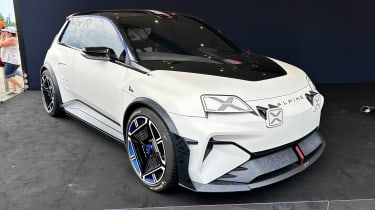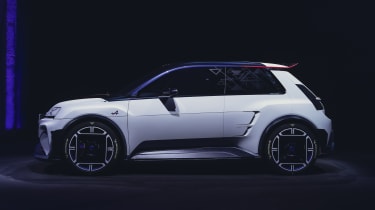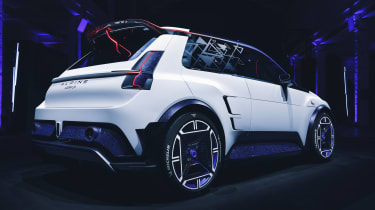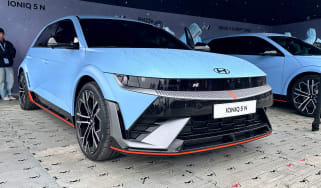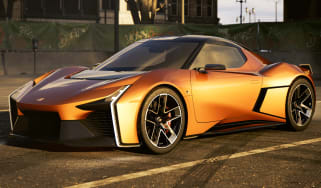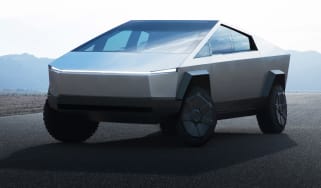Alpine A290_β: all-electric concept previews 2024 hot hatch
Alpine has plans to transform the upcoming electric Renault 5 into a thrilling hot hatch called the A290. This concept gives a tantalising taste of what we can expect
The development of a tauter, meaner version of the reborn Renault 5 is no secret, with Alpine having absorbed Renault Sport and taking the retro EV as the basis for a hot hatch. But the end result, if this A290 concept is anything to go by, might have caught you off guard – particularly if you were expecting a subtle visual enhancement in the mould of the mid‑’70s Renault 5 Alpine. The A290 is extreme. A hunkered-down, bewinged creation with muscle bursting through its bodywork, and according to Alpine’s designers, 85 per cent of what you see here will make it to showrooms in 2024.
The A290 will form part of a three-EV range that will also include an SUV. But with a battery-powered sports car – a joint project with Lotus – completing the set, Alpine clearly isn’t planning on abandoning its core customer base of driving enthusiasts in the electric age. Whether said enthusiasts will join Alpine on its EV journey is another matter…
> New Renault 5 begins testing ahead of 2024 launch
Dubbed the A290_β, or ‘beta’, signifying that the car is very a much work in progress, the concept sits on a bespoke platform with dual front motors that bears no resemblance to what the final production car will receive. And while it may look much more A110 R than A110, the message is clear – Alpine’s trademark liveability and dynamic bandwidth has been the primary focus. The A290 is intended for daily road use rather than the track, say its engineers, but whether this is by design or forced by the cooling and energy demands of its electric powertrain remains to be seen.
The CMF‑B EV front-wheel-drive architecture from the Renault 5 will sit at the A290’s core, and crucially Alpine was involved in its development to ensure that certain parameters could be met for its hot hatch. The underfloor battery pack – of an as-yet-undisclosed capacity – is a stressed member of the chassis, and Renault has invested in a multi-link rear axle as opposed to the more basic torsion beam found in the Abarth 500e, for example. The A290 will go further with its own chassis calibration, torque vectoring, A110-derived brakes, and bespoke suspension hardware with hydraulic bump-stops – a token from the now-defunct Renault Mégane RS.
If you’re wondering about the A290_β’s three-seat cabin, the GMA T.50 isn’t about to gain a small French sidekick. The interior of the concept is far from reality, with spartan trim, bare footwells and an arrow-shaped dashboard extending around the driver. Strips of red and blue ambient lighting seep through every surface, but the race-style central bucket seat and full roll-cage certainly restore a sense of focus. The production car will be far more conventional, of course, but the A290_β does tease some elements that will reach showrooms – most notably the ‘overtake’ button on the rectangular steering wheel, which provides a ten-second burst of extra power when pressed.

Alpines have never been about raw grunt though, and the A290 will be no different – its creators stress that it won’t chase headline figures or the whiplash-inducing thrust that’s typical of high-performance EVs. This is inevitable given that a dual-motor layout isn’t being considered, but the A290 is certain to eclipse the standard Renault 5 with a stronger front motor. With access to Renault’s EV toolbox, the Megane E‑Tech’s 217bhp unit appears to fit the bill, and would pull the A290 comfortably ahead of the 153bhp Abarth 500e.
So what of that design? Alpine’s F1 team was involved in creating some of the aero surfacing, which, it’s promised, will be largely carried over to the road car. The clean form of the Renault 5 has been swollen to accommodate wider tracks, giving the A290 a square footprint and serious presence for a pint-sized hatch. The show car’s wheel design will be carried over (albeit in a smaller 19-inch size) and Alpine’s X-shaped light signature will feature in the quad-headlight array, with the pair of inner lamps recalling the spotlights of the Renault 5 Maxi Turbo. Despite such references, Alpine is keen to point out that this car is forward-looking. ‘We created something completely geared for the future,’ said chief designer Raphael Linari. ‘We wanted up-to-the-minute surfaces, details and materials, a vehicle that fulfils every Alpine promise, that’s exciting, surprising, and not even remotely nostalgic or backward-looking.’
Most changes for the production version will be driven by cost or legislation, with the forged carbon panels, slimline door mirrors and vented scuttle panel being the key omissions. The fan-like outlets in the rear bumper are a reference to PC gaming, strangely, as is the show car’s ‘beta’ moniker. Indeed, the A290 will rely heavily on electronic augmentation to relay the kind of zeal that defines the best hot hatches – Alpine is working on its own driving sound signature to pipe through the speakers, and we’re expecting the usual array of drive modes and variable regen, which could add a new dimension to evoke the throttle adjustability of traditional hot hatches. Indeed, the A290’s powertrain calibration will largely define its character. The A290_β has served as a test bed for the road car’s development, allowing Alpine’s chassis engineers to experiment with torque vectoring – albeit with a much more effective dual front motor configuration – to provide a more playful balance at the limit.
With just one electric motor, the production A290 won’t be quite as advanced. Still, with precise control over torque delivery to the front wheels, the car’s attitude should be easily manipulated through software, a trick that could help mask the inherent weight disadvantage that the A290 will carry as an electric hot hatch. Emulating the feeling of low mass, rather than creating a genuine lightweight car, is the goal here.
The good news is that the Renault 5 will adopt numerous measures to save weight over the 1502kg Zoe supermini it replaces – including a reconfigured battery pack and motor electronics – which should transfer to the Alpine. Even so, instilling it with the essential character of the brand will be a challenge. Will the A290 emulate the engineering purity that catapulted the A110 to evo 5-star status? We’re looking forward to finding out.
This story was first featured in evo issue 310.

